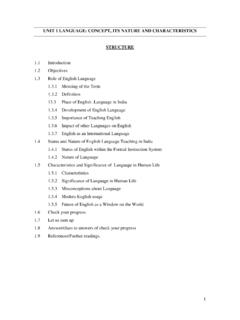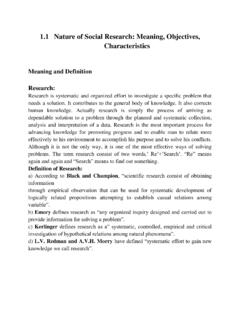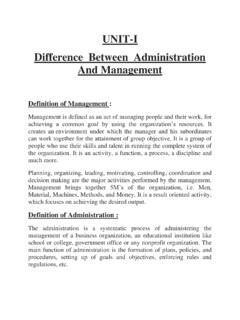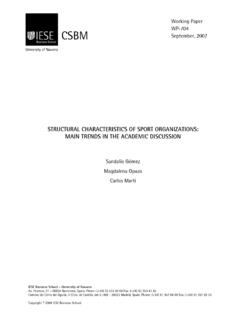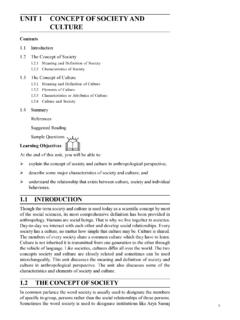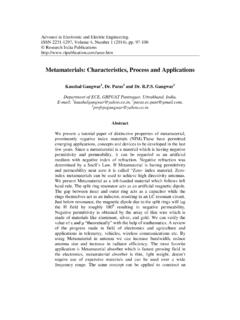Transcription of A. DEFINING CHURCH - THE CONCEPT OF A …
1 A. DEFINING " CHURCH " - THE CONCEPT OF A CONGREGATIONbyRobert Louthian and Thomas Miller"The term " CHURCH " is intended to be synonymous with theterms "denomination" or "sect" rather than to be used in the universalsense."".. [T]he word " CHURCH " implies that an otherwise qualifiedorganization bring people together as the principle (sic) means ofaccomplishing its exempt purpose. The objects of such gatheringsneed not be conversion to a particular faith or segment of a faith northe propagation of the views of a particular denomination or sect.
2 "(Emphasis supplied.)"To be a " CHURCH " a religious organization must engage in theadministration of sacerdotal functions and the conduct of religiousworship in accordance with the tenets and practices of a particularreligious body."1. IntroductionThe interesting thing about these three definitions is not that they differ, butthat they are from the same court case. In Chapman v. Commissioner, 48 358(1967), three Tax Court judges agreed that an organization was not a churchwithin the meaning of IRC 170(b)(1)(A)(i), but could not agree why.
3 The majorityopinion, which contained the first quote, and two separate concurring opinions,each emphasized a different characteristic of the word " CHURCH ."The judges in Chapman were not unique, for the meaning and scope of theterm " CHURCH " have puzzled the Service, courts, and scholars since Congressexcepted churches from the newly imposed unrelated business income tax in theRevenue Act of 1950. The task was not made easier as subsequent acts addedprovisions that distinguish churches from other religious organizations, but do notdefine " CHURCH .
4 " See various articles in the Exempt Organizations CPE texts fromthe 1978 EO ATRI at 1, to the 1992 CPE at 1. In addition, for an in-depthdiscussion of the history of the term " CHURCH " in the Code, see Whalen, " CHURCH "in the Internal Revenue Code: The Definitional Problems, 45 Fordham L. Rev. 885(1977).This article will discuss the method used to define " CHURCH ," focusing onone aspect: the CONCEPT of a congregation . Because of the nature of the term,however, it is impossible to discuss a component factor in a The Fourteen (or Fifteen) PointsIn making the required distinctions between churches and religiousorganizations that are not churches, the Service has followed the basic principlesset out in De La Salle Institute v.
5 United States, 195 F. Supp. 891 ( ). In that case the court, in deciding that a religious order operating schoolsand a novitiate was not exempt from unrelated business income tax on its winery,stated, at 903, that in the absence of a statutory definition of " CHURCH ," we shouldapply "the common meaning and usage of the word."To apply the "common meaning and usage" of the word " CHURCH ," theService attempted to identify historically or judicially recognized objectivecharacteristics of churches. The result was the so-called "fourteen points test,"which was later expanded to include a fifteenth criterion - any other facts andcircumstances.
6 The word "test" is misleading, as there is no minimum number ofcriteria an organization must meet to be classified as a CHURCH . Rather, the criteriaserve as a guide to assist case-by-case applying the analysis to determine whether a religious organization mayproperly be characterized as a CHURCH , the Service considers whether theorganization has the following characteristics: (a) a distinct legal existence, (b) arecognized creed and form of worship, (c) a definite and distinct ecclesiasticalgovernment, (d) a formal code of doctrine and discipline, (e) a distinct religioushistory, (f) a membership not associated with any other CHURCH or denomination,(g) an organization of ordained ministers, (h) ordained ministers selected aftercompleting prescribed studies, (i) a literature of its own, (j) established places ofworship, (k) regular congregations, (l) regular religious services, (m)
7 Sundayschools for religious instruction of the young, (n) schools for the preparation of itsministers, and (o) any other facts and circumstances that may bear upon theorganization's claim for CHURCH status. See IRM 7(10)69, Exempt OrganizationsExamination Guidelines Handbook, text (3).The fifteen criteria are not an attempt to quantify the factual circumstancesrequired for recognition as a CHURCH . Determinations are not made solely on thenumber of characteristics an organization possesses. Given the variety of religiouspractice, the determination of what constitutes a CHURCH is inherentlyunquantifiable.
8 Attempts to use a dogmatic numerical approach mightunconstitutionally favor established churches at the expense of newer, lesstraditional The CONCEPT of a congregation as an Important CriterionAlthough no court has specifically adopted the fourteen points test, manyhave used the criteria in rulings. One criterion that consistently appears is thepresence (or absence) of a regular congregation . The most frequently cited case isAmerican Guidance Foundation, Inc. v. United States, 490 304 (1980). Inthat case, the court, after acknowledging the fourteen points test as a useful guide,stated that "[a]t a minimum, a CHURCH includes a body of believers orcommunicants that assembles regularly in order to worship.
9 " Id. at Spiritual Outreach Society v. Commissioner, 927 335 (8th ), the court concluded that the organization was admittedly engaged inreligious activity and possessed some of the fourteen criteria discussed inAmerican Guidance Foundation v. United States, supra. The court noted that ofcentral importance is, inter alia, the existence of an established congregationserved by an organized ministry. The facts failed to show that the participants inthe organization's activities considered it their CHURCH . Thus, the participants didnot form a CHURCH of Eternal Life and Liberty, Inc.
10 V. Commissioner, 86 916,924 (1986), the Tax Court defined a CHURCH , for IRC 170(b)(1)(A)(i) purposes, as"a coherent group of individuals and families that join together to accomplish thereligious purposes of mutually held beliefs." In other words, according to the TaxCourt, a CHURCH 's principal means of accomplishing its religious purposes must beto assemble regularly a group of individuals related by common worship and the exact origin of this "associational" or "societal" component isunknown, courts have given it great weight in determining if an organizationshould be classified as a CHURCH .










